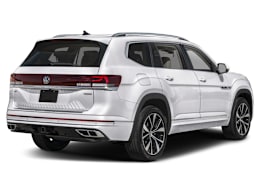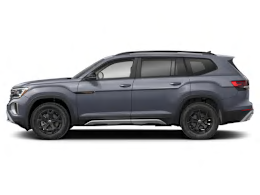After a minor refresh, the Volkswagen Atlas remains a functional midsized SUV graced with a well-crafted cabin and one of the roomier third-row seats in its class.
And, on the surface at least, the Atlas would seem to be a top choice as a functional family vehicle. The seating space is exceptionally roomy, the cargo area is enormous, and the cabin has a fit and finish level that would fool your passengers into thinking that you spent way more than you actually did.
But digging a little deeper, we found that the Atlas’ day-to-day livability requires way too many compromises. Like most cars these days, the Atlas relies on a large center touchscreen to handle basic audio, navigation, and climate functions. But the screen boots up slowly and the extensive use of touch-capacitive and touch-screen-based—rather than physical—buttons creates much frustration because it’s not easy to make even simple adjustments. Plus, the switch from a V6 engine to a turbo four-cylinder didn’t improve fuel efficiency. We also can’t recommend the Atlas due to its subpar reliability.
We’re pleased to see that the IQ.Drive advanced driver assistance system, which includes lane departure warning, lane keeping assistance, lane centering assistance, and adaptive cruise control, is standard.
We bought a Volkswagen Atlas SE with Technology package and the optional 4Motion all-wheel drive—anonymously from an area dealer, as we do with every vehicle we test—for the purpose of this road test review.
Driving experience
The 269-horsepower, 2.0-liter turbocharged four-cylinder engine packs a good punch, and it’s a second quicker from 0 to 60 mph than the previously-tested V6. But it’s not as smooth, and fuel economy remains a low 20 mpg overall, a touch behind most competitors, such as the Honda Pilot, Mazda CX-90, and Toyota Grand Highlander.
Handling agility is decent for the class, but the steering feels rather light and loose. Still, the Atlas did well when pushed to its limits around our track. The ride isn’t quite as comfortable as it was in the previous version because of larger wheels and tires and a firm suspension. Rougher pavement brings some noticeably hard hits. The cabin is fairly quiet but the engine’s vroom is a bit too pronounced.
The brakes were truly one of the highlights of our tests with the Atlas. Stopping distances were consistently short and drama-free on both dry and wet surfaces. In fact, its dry surface stopping distances were some of the shortest we’ve seen from recent three-row SUVs.
Cabin comfort
The cabin ambiance in the Atlas is a step above the previous model. You’ll find quality-looking wood trim, and a fair amount of padded and contrasting-stitched surfaces. We would totally understand if your passengers thought you bought one of the pricier German SUVs instead of a relatively pedestrian VW.
You can see reasonably well out over the Atlas' hood, something that can't be said about many new vehicles today. And most will find the multiple adjustments for the seat and steering wheel accommodate just about any size driver.
Taller drivers found the front seats comfortable, while those with shorter legs said the bottom cushion is too long; the armrests are also low and faraway. The second-row seat has lots of headroom but the bottom cushion is light on leg support.
The third row is one of the more comfortable in the class due to the bottom cushion’s height off the floor. It’s also one of the easiest to get into, thanks to a nifty mechanism that tilts and slides the second-row seat forward.
At 50.5 cubic feet, the Atlas offers more cargo room with the rear seats folded than many of its rivals.
Controls and usability
Unfortunately, most climate controls are now within the confusing infotainment touchscreen. Wrestling with the finicky touch-sensitive sliding controls for temperature and audio volume are inherently more tedious than a simple knob or button. Plus, we’re appalled that they aren’t lit at night, which makes them even more difficult to use. We also found the customizable driver’s instrument screen to be complex and distracting to use while on the road.
Despite the extensive updates VW did to the Atlas, these controls need to go back to the drawing board.
Safety
Standard active safety and driver assistance features include automatic emergency braking with pedestrian and cyclist detection, along with automatic emergency braking that operates at highway speeds, blind spot warning, rear cross traffic warning, reverse automatic emergency braking, lane centering assistance, lane departure warning, lane keeping assistance, and adaptive cruise control. An automatic high beam system is standard beginning with the 2025 model year.


























